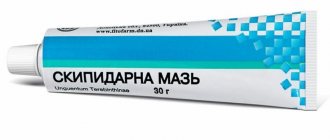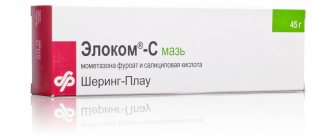Pharmacodynamics and pharmacokinetics
Pharmacodynamics
The mechanism of action of the drug is based on its ability to prevent the marginal accumulation of neutrophils and inhibit the process of macrophage , which helps to reduce the production of lymphokines , reduce inflammatory exudation and the intensity of infiltration and granulation processes. It has local anti-inflammatory, antiexudative, antipruritic and antiallergic effects.
Pharmacokinetics
The drug penetrates well through the skin (absorption no more than 1%). Absorption through the skin increases when used on skin with damaged epidermis, in the folds and on inflamed areas of the skin. Absorption also increases when the drug is applied to large areas of the skin or used frequently. Biotransformed in the liver. It is excreted in the form of glucuronic acid , in small amounts unchanged through the kidneys.
Cloveit ointment for external use 0.05% 25 g tube 1 pc. in Moscow
Latin name
CLOVATE
International nonproprietary name
clobetasol
Release form
Ointment for external use.
Package
25 g - aluminum tubes (1) - cardboard packs.
Description
The ointment is in the form of a white, translucent, oily, soft homogeneous mass.
pharmachologic effect
GCS for external use. Prevents the marginal accumulation of neutrophils, reduces inflammatory exudation and the production of lymphokines, inhibits the migration of macrophages, reduces the intensity of infiltration and granulation processes, has local anti-inflammatory, antipruritic, antiallergic antiexudative effects.
Indications
psoriasis (except for pustular and extensive plaque psoriasis); eczema (various forms); lichen planus; discoid lupus erythematosus; skin diseases resistant to therapy with less active corticosteroids for topical use.
Directions for use and doses
Apply externally. Cream or ointment is applied in a thin layer to the affected areas of the skin 1-2 times a day. The duration of a continuous course of treatment is limited to 3-4 weeks. In particularly resistant cases, especially in the presence of hyperkeratosis, the anti-inflammatory effect of Cloveit® can be enhanced by applying a polyethylene film bandage to the area of application at night, which is usually accompanied by a positive effect. When changing an occlusive dressing, the skin must be cleaned. In the future, the achieved effect can be maintained without the use of an occlusive dressing.
Compound
1 g ointment: clobetasol propionate 500 mcg Excipients: propylene glycol - 50 mg, sorbitan sesquioleate - 5 mg, white petrolatum - up to 1 g.
Contraindications
rosacea; acne vulgaris; skin cancer; nodular prurigo Hyde; perioral dermatitis; perianal and genital itching; skin manifestations of syphilis; diaper rash; bacterial, viral and fungal skin diseases (including herpes simplex, chicken pox, skin tuberculosis, actinomycosis); widespread plaque and pustular psoriasis; age up to 1 year; pregnancy; lactation period; hypersensitivity to the components of the drug.
Use during pregnancy and breastfeeding
GCS for external use should not be used during pregnancy for a long time in large doses. The safety of clobetasol during lactation has not been established.
special instructions
The drug Cloveit® ointment is recommended for use for skin lesions accompanied by dryness, hyperkeratosis, and thickening. Cloveit® cream is recommended for the treatment of acute inflammatory skin diseases, incl. accompanied by the development of weeping, as well as for the treatment of inflammation of the scalp. The drug is recommended for short-term use. Prescription of corticosteroids for external use for a long time should be avoided, especially when treating young children, as this may suppress adrenal function. The use of Cloveit® in children requires medical supervision at least once a week. Atrophic skin changes may appear on the face more often than on other parts of the body as a result of long-term use of external forms of corticosteroids. The drug should not be applied to the eye area, because use of the drug in the periorbital area may cause the development of glaucoma. Treatment of psoriasis with GCS for external use may be accompanied by the development of relapses of the disease, tolerance to the drug, a generalized pustular form of the disease, local or systemic toxic reactions due to a violation of the barrier function of the skin, so careful monitoring of the patient is especially important. If a secondary infection occurs, appropriate antibacterial therapy should be carried out. If there are any signs of generalization of the infection, it is necessary to stop the external use of GCS and carry out appropriate treatment with antibacterial drugs. The warm, moist conditions created by applying an occlusive dressing are conducive to bacterial infection, so be sure to clean the skin before applying a new dressing. It is not recommended to dilute the cream. Effect on the ability to drive vehicles and operate machinery. The use of the drug does not affect the patient’s ability to perform work that requires increased attention and speed of psychomotor reactions.
Side effects
Dermatological reactions: burning, itching, steroid acne, dry skin; with long-term use - weakening of the skin barrier function; with long-term use in high doses - atrophic changes in the skin, in particular, its thinning, the appearance of atrophic stripes (striae), dilation of superficial blood vessels, especially when applying occlusive dressings and when applying the drug to areas of skin with folds; Skin pigmentation and hypertrichosis may develop. In rare cases, treatment of psoriasis with corticosteroids for external use (or their cancellation) provokes the development of pustular psoriasis. When applied to large surfaces, systemic side effects may develop: gastritis, ulceration of the gastrointestinal mucosa, increased intraocular pressure, symptoms of hypercortisolism. Long-term administration of GCS for external use in large doses or application to large areas of the skin may be accompanied by systemic absorption with subsequent development of symptoms of hypercortisolism. The risk of developing this complication is increased in children, especially when using an occlusive dressing, while a diaper can serve as such a dressing. Provided that the drug Cloveit® is prescribed to adult patients in a dosage of no more than 50 g per week, the suppression of the function of the pituitary gland and adrenal glands is transient in nature with their rapid recovery immediately after the end of the course of treatment. In rare cases, Cloveit® may cause an exacerbation of symptoms of the disease.
Storage conditions
List B. The drug should be stored out of the reach of children at a temperature not exceeding 25°C.
Instructions for use of Cloveit (Method and dosage)
The drug in any of the dosage forms is applied to the affected skin 1-2 times a day for 20-30 days. Both Cloveit Ointment (instructions for use) and Cloveit Cream (instructions for use) can be applied using an occlusive dressing. In this case, the anti-inflammatory effect of the drug is enhanced and is accompanied by a positive effect, especially in resistant cases and in the presence of hyperkeratosis . When applying a new occlusive dressing, you must first clean the skin.
Clovate®
Local hypersensitivity reactions (see section "Side effects") may be similar to the symptoms of the ongoing disease. In some patients, as a result of increased systemic absorption of glucocorticosteroids for external use, manifestations of hypercortisolism (Cushing's syndrome) and reversible inhibition of the hypothalamic-pituitary-adrenal axis may occur, leading to the development of glucocorticosteroid insufficiency. If any of the above violations are observed, the drug should be discontinued, gradually reducing the frequency of its application, or replaced with a less active glucocorticosteroid. Abrupt cessation of treatment may lead to the development of glucocorticosteroid deficiency. During drug therapy, periodic monitoring of the function of the adrenal cortex is necessary by determining the level of cortisol in the blood and urine after stimulation of the adrenal glands with adrenocorticotropic hormone (ACTH). Risk factors for increased systemic effects include: the activity of the glucocorticosteroid and the composition of the drug for external use, duration of use, application of the drug to large areas of skin, use in closed areas of the skin (for example, in areas with diaper rash or under an occlusive dressing (diapers and nappies in infants) can play the role of an occlusive dressing)), increased hydration of the stratum corneum, use on areas with thin skin, such as the face; application to damaged skin or other conditions that may involve compromised skin barrier integrity.
Use in children Cloveit® ointment should be used with caution, especially as long-term therapy, in children over one year of age, since in this group of patients, due to a higher ratio of body surface area to body weight than in adults, a proportionally larger amount may be absorbed glucorticosteroids, dysfunction of the hypothalamic-pituitary-adrenal system will develop faster and systemic undesirable effects characteristic of glucorticosteroids will occur, including growth and development delay. If possible, long-term treatment with topical glucocorticosteroids should be avoided in children under 12 years of age, since long-term topical use of glucocorticosteroids may cause suppression of adrenal function. In children, more often than in adults, atrophic changes in the skin occur with external use of glucocorticosteroids. When prescribing clobetasol therapy to children, the course of treatment should be limited to five days, and observation by a doctor is also required at least once a week. Do not use occlusive dressings.
Use in psoriasis Cloveit® should be used with extreme caution in patients with psoriasis, due to possible relapse of the disease caused by the development of tolerance, the risk of generalized pustular psoriasis and the development of local or systemic toxic reactions due to impaired skin barrier function. Patients with psoriasis should be under medical supervision when using Cloveit® ointment.
Concomitant infection In the event of a secondary bacterial or fungal infection, it is necessary to prescribe external use of an antibacterial or antifungal drug. If symptoms of infection spread, you should stop using Cloveit® until the infection is cleared.
Risk of Infection from Occlusion Warm, moist conditions in skin folds, as well as the conditions created when applying an occlusive dressing, favor the development of bacterial infection. When using an occlusive dressing, the skin should be cleaned before applying a new dressing.
Chronic leg ulcers Glucocorticosteroids for external use are in some cases used to treat dermatitis around chronic leg ulcers. However, such use may be accompanied by an increased incidence of local hypersensitivity reactions and an increased risk of local infections.
Application on the skin of the face and eyelids Since the skin of the face is more susceptible to the development of atrophic changes, the use of Cloveit® is undesirable. When prescribed - therapy for no more than 5 days. Clovet® should be used with caution on the skin around the eyes or eyelids due to the risk of developing glaucoma or cataracts, as well as in patients with a history of these diseases, who may experience an exacerbation of these diseases. Avoid contact of Cloveit® ointment with the eyes and mucous membranes. If the drug accidentally gets into your eyes, rinse them thoroughly with water.
Risk of developing central serous chorioretinopathy If a patient experiences symptoms such as blurred vision or other visual disturbances, consider referring the patient to an ophthalmologist to determine possible causes of the disturbance, which may include cataracts, glaucoma, or rare diseases such as central serous chorioretinopathy .
Use in elderly patients The drug should be used with caution in case of existing atrophic changes in the subcutaneous tissue, especially in the elderly.
Interaction
The simultaneous use of Cloveit with drugs that inhibit CYP3A4 ( itraconazole , ritonavir ) leads to inhibition of the metabolism of corticosteroids and contributes to the development of systemic complications. No interactions of the drug when used externally with other drugs for external use were noted. It is not recommended to carry out any immunization while using the drug due to the possible disruption of an adequate immunological response.
Cloveit price, where to buy
The price of Cloveit ointment 0.05% in a 25 g tube varies between 328-358 rubles per package. The price of Cloveit cream 0.05% in a 25 g tube is 330-408 rubles per package. You can purchase Cloveit ointment and Cloveit cream in pharmacies in Moscow and other cities without difficulty.
- Online pharmacies in RussiaRussia
- Online pharmacies in UkraineUkraine
- Online pharmacies in KazakhstanKazakhstan
ZdravCity
- Cloveit cream for external use
approx. 0.05% tube 25gJelfa SA RUR 359 order - Cloveit ointment 0.05% 25gJelfa SA
RUB 362 order
Pharmacy Dialogue
- Cloveit (0.05% ointment 25 g)Polfa
RUR 398 order
- Cloveit (0.05% cream 25g)Polfa
RUR 378 order
show more
Pharmacy24
- Cloveit 0.5 mg/1g 25g cream Elfa A.T. Pharmaceutical Plant, Polshcha
86 UAH order - Cloveit 0.5mg/1g 25 g ointment Elfa A.T. Pharmaceutical Plant, Poland
86 UAH order
PaniPharmacy
- Cloveit ointment Cloveit cream tube 25g Poland, Jelfa
101 UAH order
- Cloveit ointment Cloveit ointment 0.5 mg/g tube 25g Poland, Jelfa
93 UAH order
show more



